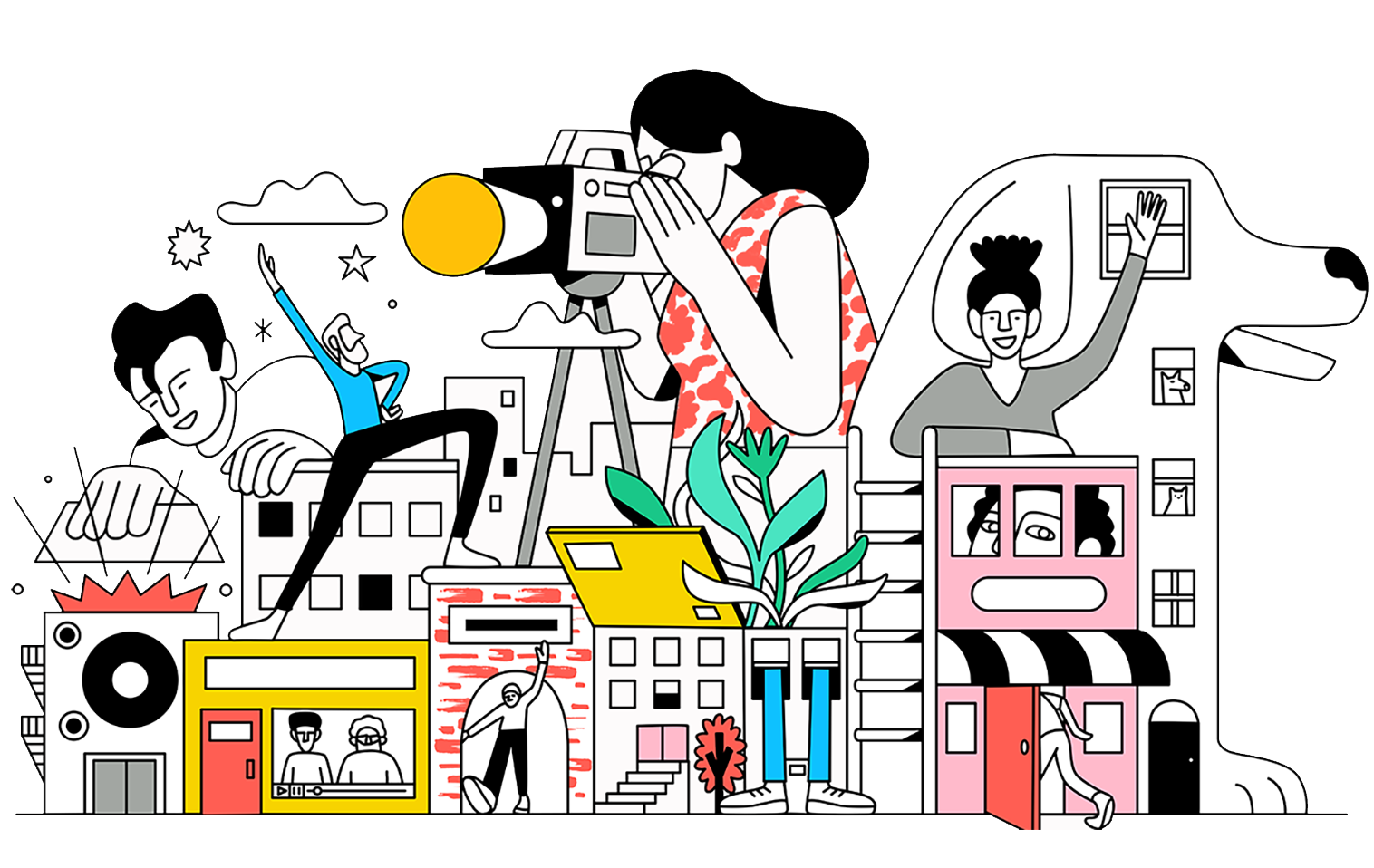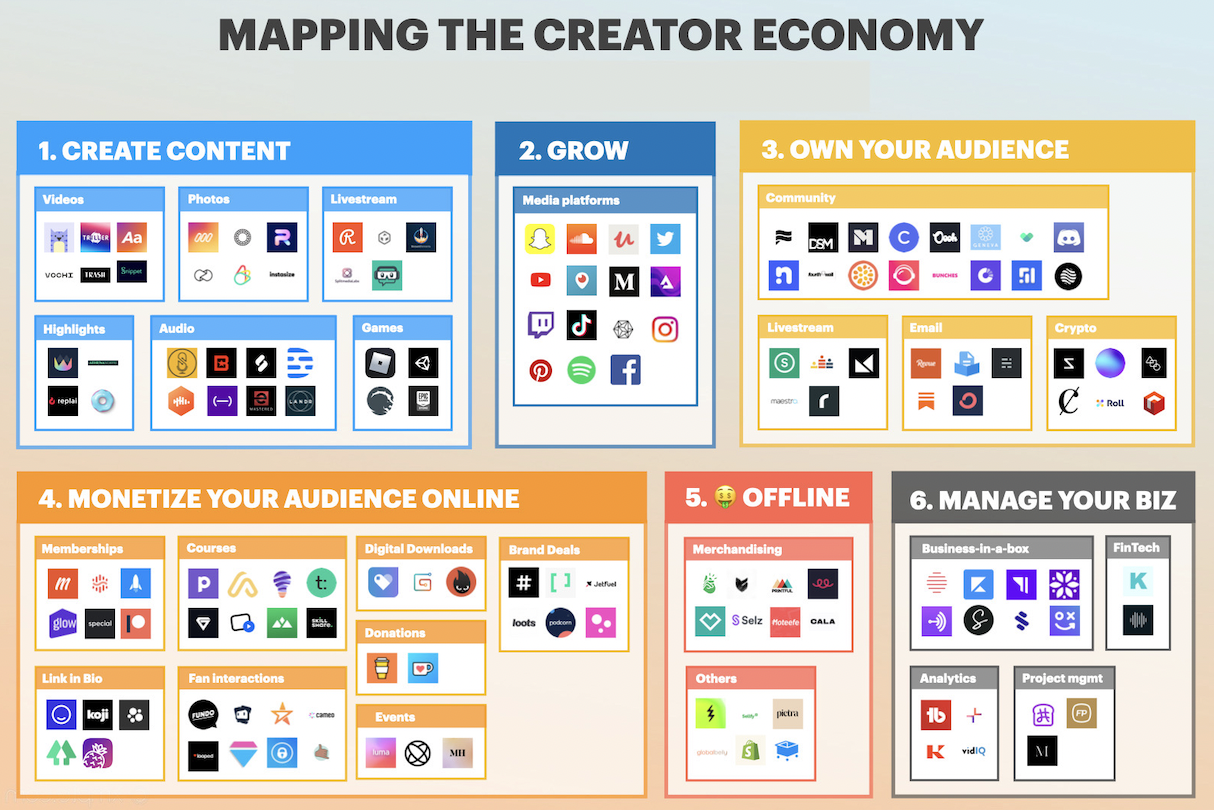
Some call it the Passion Economy, some go with Creator Economy, but what is it really? A very fascinating movement is unfolding in the lives of those who crave flexibility, freedom and creative outlets at work and in their everyday lives.
Platforms, apps and mediums are being promoted to people with different creative abilities which has led to the rise in the ‘Creator Economy’.

Source: ArmTheCreators.com
In the above image we see that the use of traditional social media platforms such as Facebook, Instagram, Snapchat, etc. are evolving to create more opportunities for creators to monetize their own content with platforms such as Patreon, Kajabi, Teachable, Twitch, etc. it’s evident to see the migration from Web 2.0 to 3.0, this will be the Block Chain / Crypto era.
Manifest this: I’m going to make a living doing and creating what I love and what I’m passionate about.

Source: Pearl Agarwal on Medium
Let’s delve into the Creator Economy movement by taking a brief look at the history of the internet:
- Web 1.0: The Internet Age (our lives would never be the same…)
Also known as the ‘Information Age’ where computers and the internet were widespread. It was the age with the height of innovation bringing the internet closer and closer to us, and eventually quite literally in our pockets, through the invention of the smart phone.
- Web 2.0: The Digital Age (social media era; picture or it didn’t happen?)
The mainstream use of the internet created the digital age as we know it. This is when Instagram, Facebook, Twitter, Snapchat and YouTube dominated the industry with their ability to allow users to interact online, share content, and explore their creativity. The rise of influencers and influencer marketing was a notable aspect of this era as this was the primary cause to shift from the digital economy to the creator economy. Influencers were being featured in brand endorsements, ads, campaigns, etc. in this era, the social media ‘influencers’ started becoming self-employed people who relied on digital platforms to express, create and earn an income.
- Web 3.0: The Creator Economy
The influencers / creators in the digital age who relied on brands to earn an income are now building their own brand based on their unique talent, creative skills, never seen before ideas, topics, and / or their passions. This creates the rise of digital platforms that allow these creators and their followers to connect in a space regarding their niche. This is when platforms such as Twitch (gaming and entertainment), Podia (selling knowledge and courses), etc. come in play.
So, what kind of content can creator’s produce in this economy?
The future is for freelancers. If you can do one or more things you’re passionate about and make it your full-time job, while being self-employed and flexibly working, you’re a freelancer.
The possibilities are endless, I’m a bit overwhelmed myself. People are getting incredibly creative, and surprisingly, there’s always an audience ready to feed on what they have to offer.

Here’s a list of things I put together that freelancers can do which would most likely be huge in the creator economy:
- Graphic design
- Photography
- Videography
- Poetry
- Writing
- Culinary
- Motivational speeches, protesting, etc.
- Podcasts
- Art
- DIY’s
- Fashion design
- Dancing
- Singing
- Music
- Illustrations
- Courses (teaching, designing, languages, speaking, anything you can imagine)
- Pottery
- Comics
- Fitness
- Yoga and meditation
There’s truly an endless list of infinite options, and I’m sure we’ll be seeing the immergence of many more creative jobs of this kind.
“To be a successful creator you don’t need millions. You don’t need millions of dollars or millions of customers, millions of clients or millions of fans. To make a living as a craftsperson, photographer, musician, designer, author, animator, app maker, entrepreneur, or inventor you need only thousands of true fans.” – Kevin Kelly
If you’re still a bit confused about it all (which I was too at the start), check out this 5-minute run through video explaining what the creator economy is:
Let’s talk Block chain and the Metaverse…
It’s important to understand that the rise of this economy is a result of creators wanting to essentially own their content and the platform they post it on. When the platform makes money so do they.
In order for a content ownership policy to be designed, voting rights come in to play which is done through block chain consent. Not even a president can dispute the consensus reached on block chain.
Let me put this in simple terms, web 3.0 is basically a decentralized country (the metaverse) on the internet with a large population (of content creators and their audiences) and with a democratic leadership system (block chain).
“Blockchain is going to allow information that shouldn’t be free, not to be free. Remember Napster? You could download music for free and nobody, not even the sooks in the band Metallica, could stop you.” Mike Novogratz, Serial Entrepreneur.
The Next Generation

Abdullah Al Ghafri, known as QQQ by his social media followers, took less than a year to reach 1 million followers on YouTube. In an interview with him he says:
“I started everything on Snap chat- it’s an incredible app, Snap chat is different. Why? Because it’s real. These days we go on Instagram and can see many people have about two million – four million followers. They almost show a fake reality. However, on Snap chat, everything is real. I wanted to be a part of the YouTube community; many people encouraged me to do so a few years ago but I waited. YouTube needs a whole team. And yeah, seven months ago I said, I have to start on YouTube, but in very high quality, you know, like more, maybe more than TV. These days, 80% of the kids I’m sure want to be singers. They want to be football players. They want to be on social media dancing or something.”
Storytelling on social media platforms is no longer Childs play. Content creators don’t just do it to pass time or as a side hustle. In the next generation, the creator is a full-time job and a primary method to earn income. As technology becomes mainstream and social media has become very much integrated into our daily lives, creators are already monetizing off of web 3.0 and the ‘creator economy’. With that being said, this will be a slow and steady growth for most creators since the new web has still not come into full play as of yet.
Who are the Consumers in the Creator Economy?
The consumers in this economy were social media followers in the previous eras. The creators / influencers bring them along with them on their story telling journey and continue to target their niche content to them. These consumers are very willing to buy products / services from these creators as firstly, they’re a loyal fanbase, and secondly, have admired their work and trust them more than other ads they see from companies who they don’t know personally.
Here are my final thoughts…
The Creator Economy is coming, slowly but surely, in many industries such as graphic design, gaming, entertainment and broadcasting. There may be some influencer fatigue in the beginning stages. I can say for sure I’m quite overwhelmed yet excited by all of this myself, but I see a future where we’re operating in the Metaverse and using crypto as money, though this is still in its infancy stages. it will be exciting to watch the new ‘creators’, ‘freelancers’ and ‘influencers’ be creatively liberated by platforms designed for them and for their niche customers. Because, while social media apps such as Tik Tok, Instagram and Facebook have high rates and a large audience, they benefit more from creators than vise versa.
Stay tuned with news about the Creator Economy, subscribe to this podcast.
References:
https://www.armthecreators.com/mapping-the-creator-economy/
https://kk.org/thetechnium/1000-true-fans/
https://medium.com/eximius-ventures/web-3-0-101-c75cda55f0fa

Very insightful, interesting to see how the internet is moving to Web 3.0 and how the creator economy will unfold.
Very informative !!
Such an insightful, inspiring and an interesting read! I do indeed concur with how platforms benefit more from the creators, hence why a large proportion of content creators are provided with the insights, tools, and training to enhance their content
Looking forward to reading more of your well research and thought out work.
An interesting read..as a parent I’m still fascinated how unboxint toys became so popular!
An insight read! Excited to see what comes next
Really helped me visualize the progress of the digital world! Enjoyed the read and the referenced videos thoroughly.
The way the world is moving is actually amazing, I hope we continue to see such breathtaking yet fascinating changes in our society
A great read! Enjoyed every bit of it, it really is an eye opener of how fast the world now operates compared to the years that have passed.
Worth the read, I would love to read more of your blogs!
This is amazing!!! Thank you
Very interesting!
Great take on the future of the creator economy and the shift/potential of web 3.0, interesting to see how crypto will be the new frontier in the creator economy.
It’s very interesting how all of this changes!
Insightful. Would like to learn how businesses can monetize this movement
Very informative and very well written. Well done!
Very insightful and an exciting time!
Super interesting to see how the creator economy and the Metaverse are working hand in hand. Great read 👏🏼
This is a very interesting and informative read. We are wondering what is going to be the next stage of the creator economy! Looking forward to to read more of your blogs.
Very insightful and educative blog!
Pleasure reading this, very informative!
Very insightful! And definitely something corporates should keep in mind as part of their strategy.
Very informative & interesting Alia!